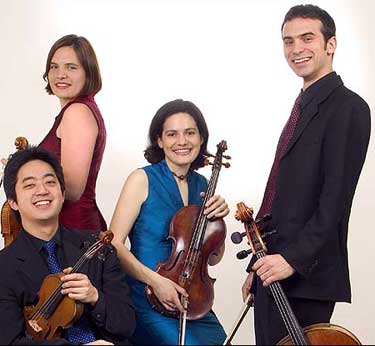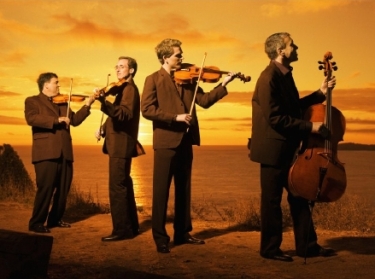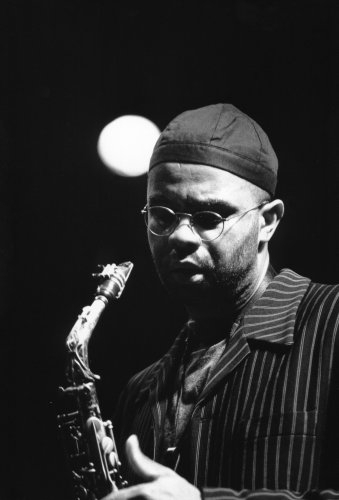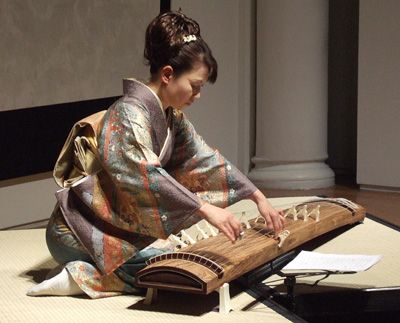Jupiter String Quartet at the Freer
By Stephen Brookes • The Washington Post • October 31, 2008
A
s you'd expect from a group that's named itself after the king of the gods, the Jupiter String Quartet doesn't lack for confidence. This gifted and youngish foursome presented an ambitious program Wednesday at the Freer Gallery of Art that showcased two challenging, rarely heard works from Russia -- and brought them off superbly.
 Dmitri Shostakovich's Quartet No. 7 may be the composer's most personal work; it's certainly one of his most moving. Dedicated to his late wife, it's a soul-tearing howl of love and anguish that, in the right hands, is riveting. The Jupiter players tore into it with real fire, turning in an involving, deeply empathetic performance that gripped the heart and never let go.
Dmitri Shostakovich's Quartet No. 7 may be the composer's most personal work; it's certainly one of his most moving. Dedicated to his late wife, it's a soul-tearing howl of love and anguish that, in the right hands, is riveting. The Jupiter players tore into it with real fire, turning in an involving, deeply empathetic performance that gripped the heart and never let go.
Shostakovich's onetime student Sofia Gubaidulina is less well known, but she’s one of the most important and original composers alive, writing with a seriousness of purpose that makes most of her contemporaries look like dabblers. Her Quartet no. 2 from 1987 is a case in point: opening simply on a single note passed among the players, it blossoms into an exalting and utterly beautiful work that glows with a fierce radiance. The Jupiter played with equal parts daring and understanding, and it was impossible to tear your ears away.
Haydn’s Quartet in F, op. 77 no. 2 -- the last he ever wrote – opened the evening, and it brims with that mix of elegance and bomb-throwing subversion that keeps his music alive. The Jupiter brought it off with freewheeling excitement and precise ensemble playing, and closed with a fine, full-blooded account of Beethoven’s Quartet in E Minor, op. 59, no.2, one of the much-loved “Razumovsky” quartets.
Turtle Island Quartet & the Assad Brothers
By Stephen Brookes • The Washington Post • October 20, 2008
 T
T
he title of Saturday night's program at the George Mason Center for the Arts was "String Theory," but it wasn't a lecture for the astrophysicist set. The theory in question was whether classical musicians can throw off their chains and play anything from jazz to world music, and there to test the case were two of the most formidable crossover groups on the planet -- the Turtle Island Quartet (which just won a Grammy for its take on the music of John Coltrane) and the brilliant guitar duo of Sergio and Odair Assad, whose repertoire ranges from Couperin to Gershwin to Antonio Carlos Jobim.
It was a mighty teaming, and in a virtuosic program that started with bop and ended in New Age pastiche (with stops along the way for '70s fusion, 20th-century classical and Argentine tango), there were moments of real and striking beauty. In particular, the Assad brothers (so gifted they could make Bulgarian drinking songs sound good) turned in achingly nuanced accounts of Isaac Albéniz's "Cordoba" and their own highly personal "Tahhiyya Li Ossoulina."
But for all that, it was a rather tame evening. It's not easy to combine the intellectual precision of the classical world with the spontaneity and sensuality of jazz and pop, and the Turtles' take on tunes such as Coltrane's "Moment's Notice" often sounded like pale, bloodless imitations of the real thing. There was more electricity onstage when the Assads joined the quartet for Latin American works including Sergio Assad's "Djembe" and Astor Piazzolla's "Verano Porteno" -- intricate, multi-layered music brought off with elegant grace -- but the evening overall had the feel of an academic exercise: well-played and thoughtful, but without much fire at its core.
Kenny Garrett at Blues Alley
By Stephen Brookes • October 17, 2008
 T
T
he alto saxophonist Kenny Garrett has long been known for his adventurous, forceful explorations into everything from hard bop to serious funk. There’s an eruptive power to his playing that can be almost overwhelming, but he rarely wastes a note or throws away a phrase, soloing with the intensity – and unstoppable logic – of a volcano.
All that firepower was on display Thursday night at Blues Alley, where Garrett opened a four-night run with one of the take-no-prisoners rhythm sections he’s long favored. Drawing largely on material from his new release, “Sketches of MD: Live at the Iridium”, Garrett turned in a ferocious but almost joyful set – from the exuberant meditations of “Intro to Africa” (which opened the evening) to the playful, township-flavored rhythms of one of his earlier works, “Charlie Brown Goes to South Africa.” And for all its physicality (the dance beat of “Happy People” is pretty much irresistible), it was a night of thoughtful, imaginative and profoundly warm playing.
Much of the credit goes to Garrett’s band, particularly Corey Henry, a gifted organist whose chimerical and wildly inventive solos drew on everything from bop to gospel to film noir on acid, and Kona Khashu, who provided solid support on the bass. But Garrett seemed to be most in tune with drummer Ronald Brunner. Laying down a complex, intricate (and sometimes impenetrable) beat, Brunner provided Garrett with a high-energy foundation, and the two often faced each other to play. When they did, the electricity was palpable – and the music soared.
Anne-Sophie Mutter at the Kennedy Center
By Stephen Brookes • The Washington Times • October 13, 2008
Is there anything new to say about the music of Johann Sebastian Bach? The redoubtable violinist Anne-Sophie Mutter thinks so - at least, that was the impression she gave in a highly personal and thought-provoking performance at the Kennedy Center Saturday night.
 Focusing on some of Bach's best-known works for violin, Miss Mutter played them on an almost heroic scale, but infused with a rare human warmth that was absolutely riveting; a performance as fresh as it was moving.
Focusing on some of Bach's best-known works for violin, Miss Mutter played them on an almost heroic scale, but infused with a rare human warmth that was absolutely riveting; a performance as fresh as it was moving.
Backed by the 17-member Camerata Salzburg, Miss Mutter shone in two of Bach's violin concertos, No. 1 in A Minor (BWV 1041) and No. 2 in E (BWV 1042). Both have been played to numbing familiarity, but they're magnificent works in the right hands, and Miss Mutter turned in intense, detailed accounts that probed constantly for meaning. She took risks, shaping the music with a restrained rubato and turning even the most dancelike movements into exercises in introspection. But it was clear that she always knew precisely what she was after, and by refusing a play-it-safe approach to Bach, she made the works her own.
The up-and-coming Norwegian violinist Vilde Frang joined Miss Mutter for Bach's engaging Concerto in D Minor for Two Violins (BWV 1043). Miss Frang, who is only 22, lacks the depth and gravitas of her mentor, and it was always clear who was in charge. But she's ferociously gifted, and one of the high points of the evening was the concerto's second movement - the soaring and wrenchingly beautiful Largo ma non tanto - in which the two violinists played their distinctive personalities against each other, with superb results.
The concert closed with a more off-the-beaten-track work, an arrangement of Giuseppe Tartini's Sonata in G minor, known as "Il Trillo del Diavolo" (The Devil's Trill). The piece supposedly came to Tartini in a dream, and it has a fantastic quality to it, full of color and wild displays of virtuosity - not Bach, maybe, but still a fun showpiece for any violinist. It looked like it would make a playful end to the evening, but Miss Mutter approached it with a surprising amount of seriousness and respect. From the tender opening to the fearless close, she found depths that (to these ears, anyway) were completely unexpected - and isn't that exactly what great musicians are supposed to do?
Time for Three at the Kennedy Center
By Stephen Brookes • The Washington Post • October 7, 2008

ccording to conventional wisdom, classical musicians just cannot get funky. Ask the average string ensemble to improvise on a blues riff, and the results are likely to be comically stilted -- an embarrassment to everyone concerned.
But as the genre-busting trio Time for Three proved Sunday night at the Kennedy Center, it doesn't have to be that way. Trained to within an inch of their lives at the Curtis Institute of Music, the trio -- Zachary DePue and Nicolas Kendall on violins, with Ranaan Meyer on double bass -- have turned their sights on everything from jazz to Gypsy melodies, and the results are spectacular. Combining the polished virtuosity of the classical world with the raw energy of a bluegrass fiddle festival, they brought the house down with the blistering pyrotechnics of "Wyoming 307" and "Forget About It" (two jazzy pieces by bassist Meyer) and the haunting, hymnlike "Hallelujah" by Leonard Cohen. And there was nothing stilted about any of it; this was high-octane playing from first note to last.
The concert was, in fact, a celebration of the fifth anniversary of the Kennedy Center's laudable Conservatory Project, and 14 players from music schools across the country followed the trio onstage for Aaron Copland's classic "Appalachian Spring." The gifted 21-year-old conductor Teddy Abrams led the group in a luminous, detailed performance; it was clear he knew exactly what he was going for, and he turned in a precise and always engaging reading. But the most fun came when Time for Three joined the conservatory players, closing the evening with a performance of Meyer's freewheeling "American Suite" that brought the audience to its feet.
Sonya Kitchell at Iota
By Stephen Brookes • The Washington Post • October 6, 2008
 Sonya KitchellGiven that she's barely out of high school, there's not much baby fat left in Sonya Kitchell's music. In fact, the singer-songwriter (who, at 19, has just released her second disc) is emerging as an adventurous musician subtle beyond her years, with a grit-and-honey voice that does pretty much whatever she wants it to -- and she wants it to do a lot.
Sonya KitchellGiven that she's barely out of high school, there's not much baby fat left in Sonya Kitchell's music. In fact, the singer-songwriter (who, at 19, has just released her second disc) is emerging as an adventurous musician subtle beyond her years, with a grit-and-honey voice that does pretty much whatever she wants it to -- and she wants it to do a lot.
She's been exploring everything from jazz (recently touring with Herbie Hancock) to pop to country. But on Saturday night at Iota she tore into an hour of the smart, thinking-person's folk-rock that may show off her voice at its best.
Focusing on material from her new disc, "This Storm," Kitchell seemed utterly confident, growling through the bluesy "Running," soaring ethereally in "Walk Away" and unleashing pure adrenaline in the white-hot "Fire." Even a too-cute take on the 1920s hit "Tonight You Belong to Me" came off with style.
While the evening belonged to Kitchell, it was genius to team her up with the avant-rock trio The Slip. Her songs don't really push the limits of folk-rock, but guitarist Brad Barr added a provocative edge to the evening, carving out dark solos that exploded periodically into detailed hurricanes of sound. It made a perfect foil for Kitchell's singing, and pushed her music into a new -- and extremely interesting -- world.
New Japanese Music at the Freer Gallery
By Stephen Brookes • The Washington Post • October 3, 2008
he pianist Kathryn Woodard has made a specialty of pushing music across cultural borders -- she was the first to play John Cage in darkest Kyrgyzstan, for instance. On Thursday night, she brought that intrepid spirit to the Freer Gallery's Meyer Auditorium, teaming up with the redoubtable koto player Masayo Ishigure and three other musicians to plumb the deep, shimmering currents of 20th-century Japanese music.
 Masayo IshigureContemporary Japanese composers have, for better or worse, been profoundly influenced by their European counterparts over the past hundred years, and the program opened a fascinating window on this rather one-sided fertilization.
Masayo IshigureContemporary Japanese composers have, for better or worse, been profoundly influenced by their European counterparts over the past hundred years, and the program opened a fascinating window on this rather one-sided fertilization.
Sometimes the results were harmless; Michio Miyagi's 1929 work, "The Sea in Spring" for koto and violin was a pretty, impressionistic work, distinctively Japanese both in musical language and overall contemplating-nature-by-moonlight esthetic approach. Other pieces, though, just seemed awkward; Kosaku Yamada's 1914 "Seven Poems" was a dutiful hodgepodge of borrowed styles (Scriabin, notably) picked up from his studies in Europe. And Maki Ishii's aggressively brainy "A Time of Afterglow" from 1983 was difficult to warm to (he studied serialism in Berlin in the 1960s, poor guy) despite a virtuosic and attentive performance by Ishigure with Theresa Salomon on violin.
But several works were nothing short of stunning. Salomon's violin swooped and circled over a measured piano line in Somei Satoh's mesmerizing "Birds in Warped Time II" from 1980, building an immense, cathedral-like effect from minimal gestures. Cellist James Wilson turned in a terrific account of Toshiro Mayuzumi's 1983 "Bunraku," a colorful, imaginative soliloquy streaked through with strange wit. But the most accomplished work of the evening was without doubt Toru Takemitsu's "Between Tides." It's as compelling and unfathomable as a dream, and the players brought it off with a perfect feel for its dark, elusive poetry.

